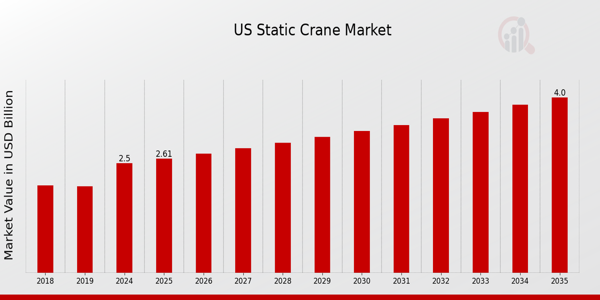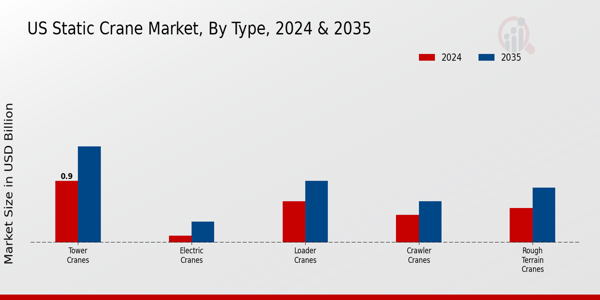US Static Crane Market Research Report: By Type (Tower Cranes, Loader Cranes, Rough Terrain Cranes, Crawler Cranes, Electric Cranes), By Lifting Capacity (Under 10 Tons, 10 to 20 Tons, 20 to 50 Tons, Above 50 Tons), By Power Source (Electric, Hydraulic, Internal Combustion Engine, Hybrid) and By Application (Construction, Mining, Shipping Port Handling, Manufacturing) - Forecast to 2035.
US Static Crane Market Overview:
As per MRFR analysis, the US Static Crane Market Size was estimated at 2.27 (USD Billion) in 2023. The US Static Crane Market Industry is expected to grow from 2.5(USD Billion) in 2024 to 4 (USD Billion) by 2035. The US Static Crane Market CAGR (growth rate) is expected to be around 4.365% during the forecast period (2025 - 2035).
Key US Static Crane Market Trends Highlighted
The US Static Crane Market is currently witnessing several important trends driven by factors such as increased construction activity and infrastructure investments. The ongoing focus on upgrading transportation networks, bridges, and urban development projects is significantly boosting demand for static cranes. Government initiatives to enhance infrastructure, coupled with the need for modernization of existing facilities, serve as key market drivers. In recent years, there has been a notable shift towards incorporating advanced technologies in crane operations, including automation and telematics. This trend enhances operational efficiency, safety, and allows for better project management, making it attractive for construction firms focusing on productivity.There are remarkable opportunities to be explored, especially in the green construction and sustainable building solutions. The rising emphasis on environmentally friendly practices is prompting firms to adopt cranes that comply with stricter emission standards. Additionally, the growth of e-commerce is leading to a surge in warehouse construction, creating further demand for static cranes specifically designed for heavy lifting. Another opportunity lies in the rental market, where companies are increasingly seeking short-term rental solutions for specific projects, allowing them to reduce capital investment while still accessing high-quality equipment.Trends in recent times also reveal a rising attention on safety and operator training within the industry. With accidents potentially leading to costly delays and liability issues, companies are focusing on not just the equipment, but also on comprehensive training programs for operators. The development of hybrid and electric crane technologies is gaining traction, aligning with the wider industry shift toward sustainability. Altogether, these trends signify a dynamic phase for the US Static Crane Market, as it adapitates to both technological advancements and evolving market demands.

Source: Primary Research, Secondary Research, MRFR Database and Analyst Review
US Static Crane Market Drivers
Infrastructure Development Initiatives
The US Static Crane Market Industry is significantly driven by the continuous push for infrastructure development across the country. According to the American Society of Civil Engineers, approximately 4 trillion USD is needed over the next decade to improve the nation's infrastructure which includes roads, bridges, and public transportation systems. This massive requirement indicates a renewed focus on construction, where static cranes play a crucial role in lifting and transporting heavy materials.Additionally, the Federal Highway Administration announced a projected 20% increase in funding for infrastructure projects over the next five years, which will further enhance the demand for static cranes in the construction sector. With major players in the market, such as Manitowoc and Terex Corporation, focusing on innovative crane technology and expanding their fleets, the US Static Crane Market is poised for significant growth as these infrastructure projects roll out.
Rise in Construction Activities
There has been a notable resurgence in construction activities within the United States, fueled by both residential and commercial real estate demands. The US Census Bureau reported a 10% increase in residential construction permits issued between 2021 and 2022, indicating a sustained growth trajectory in housing development. Major construction firms like Bechtel and Turner Construction Company are ramping up projects to meet this demand, creating more opportunities for the US Static Crane Market Industry.This trend shows a direct correlation with the increasing utilization of static cranes for efficient material handling and job site adaptability.
Technological Advancements in Crane Design
The technological advancements in static crane design and functionality are becoming a driving force in the US Static Crane Market Industry. Modern cranes are being developed with smart technologies that enable enhanced control and automation, significantly improving operation efficiency and safety on construction sites. The National Institute for Occupational Safety and Health emphasizes that automated cranes can reduce accidents and enhance productivity by up to 30%.Companies like Liebherr and Konecranes are investing heavily in Research and Development to innovate and produce next-generation cranes, expected to increase market demand in the US as construction companies look for safer and more efficient equipment.
US Static Crane Market Segment Insights:
Static Crane Market Type Insights
The US Static Crane Market is experiencing notable dynamics driven by various types of cranes that serve distinct functional needs across the construction and industrial sectors. Each type presents unique advantages and caters to different operational requirements, thereby shaping the overall market landscape. Tower cranes are particularly significant in urban construction, providing immense lifting capabilities and height advantages that facilitate the erection of skyscrapers and large structures. Their ability to rotate and extend enables efficient coverage of extensive sites, making them indispensable in high-rise developments. Loader cranes, known for their versatility, often serve in transportation and logistics, allowing for efficient loading and unloading of materials directly from trucks and platforms. This adaptability is a crucial factor that has contributed to the steady demand for loader cranes across the US market.Rough terrain cranes are specifically designed to navigate challenging outdoor environments, and their off-road capabilities are essential for industries such as construction and mining. These cranes provide key advantages in maneuverability and stability on uneven surfaces, which has accelerated their adoption in construction sites across the United States. In contrast, crawler cranes are favored for their stability and lifting proficiency in heavy-duty applications, often employed in large-scale projects that require robust support over uneven terrain. This segment's dominance in high-capacity lifting operations has made it a pivotal part of the market. Furthermore, the rise in awareness and adoption of electric cranes signifies a growing interest in sustainable practices within the industry. These cranes contribute to reducing carbon footprints and minimizing operational noise, aligning with modern eco-friendly construction trends.As the US Static Crane Market continues to evolve, understanding the segmentation based on type becomes critical. The growth trajectories of these crane types reveal how they meet industry demands and technological advancements while responding to challenges such as labor shortages and regulatory pressures. Each crane type plays a vital role in shaping the overall market growth through its specific applications and unique efficiencies, which collectively enhance productivity and project outcomes across multiple industries. Thus, an in-depth look into the various types affirms their integral roles and contributions to the US Static Crane Market landscape while highlighting the continuous innovations that fuel their advancements.

Source: Primary Research, Secondary Research, MRFR Database and Analyst Review
Static Crane Market Lifting Capacity Insights
The Lifting Capacity segment of the US Static Crane Market is pivotal in determining the operational efficiency and effectiveness across various industries, particularly in construction, manufacturing, and logistics. The various weight classifications under this segment cater to diverse operational needs, with smaller cranes, such as those capable of lifting Under 10 Tons, often being employed for lightweight tasks in urban environments, facilitating tighter spaces and enhancing productivity. Conversely, cranes with capacities ranging from 10 to 20 Tons support medium-scale tasks and are frequently utilized on construction sites where moderate loads are the norm.The 20 to 50 Tons category plays a crucial role in heavy-duty applications, allowing for the lifting of substantial equipment or materials necessary for large-scale construction projects. Lastly, cranes with lifting capacities Above 50 Tons are essential in specialized industries, where high-load tasks are routine, such as in energy or shipbuilding sectors. The segmentation demonstrates the diverse applications and importance of static cranes in contributing to infrastructure and industrial development across the US, aligning with market growth trends driven by increased construction activities and demand for efficiency.The US Static Crane Market statistics emphasize the significance of understanding lifting capacities to tailor equipment to specific project requirements while promoting safety and operational efficiency.
Static Crane Market Power Source Insights
The US Static Crane Market is experiencing notable growth in its Power Source segment, which plays a pivotal role in the functionality and efficiency of cranes across various industries. This segment includes diverse sources such as Electric, Hydraulic, Internal Combustion Engine, and Hybrid systems. Electric power sources are gaining traction due to their lower operational costs and reduced emissions, aligning with the US government's push for sustainable technologies. Hydraulic systems continue to be significant due to their powerful lifting capabilities and reliability in heavy-duty applications, common in construction and infrastructure projects.Internal Combustion Engines remain important, primarily in remote areas where electric capabilities are limited, providing the necessary mobility and power. Meanwhile, Hybrid systems are emerging as a favored option, combining the strengths of both electric and combustion engines to enhance performance and reduce environmental impact. The evolving preferences towards these power sources signify a transformation in operational efficiencies and environmental responsibility, aligning with broader market trends in the US Static Crane Market industry that reflect growing demand for innovative and sustainable power solutions.
Static Crane Market Application Insights
The Application segment of the US Static Crane Market reveals a diverse landscape, underpinned by critical sectors such as Construction, Mining, Shipping Port Handling, and Manufacturing. In the construction sector, static cranes play a vital role in lifting heavy materials, significantly enhancing productivity and safety on sites. The mining industry relies on these cranes for transporting materials from hard-to-reach locations, promoting operational efficiency. In Shipping Port Handling, static cranes are essential for loading and unloading cargo, thus facilitating seamless logistics and trade activities.Moreover, the Manufacturing sector employs static cranes for assembly line operations and managing heavy equipment, contributing substantially to workflow effectiveness. As these applications grow in prominence, they provide substantial opportunities for innovations in crane technology and automation, catering to the increasing demand for efficiency and safety in various operations. Overall, the Application segment is pivotal within the US Static Crane Market, driving advancements and investments across multiple industries, which ultimately bolsters economic growth.The market growth is further supported by trends such as infrastructure development and the push towards sustainable practices, positioning the sector for significant developments in the coming years.
US Static Crane Market Key Players and Competitive Insights:
The US Static Crane Market is characterized by a diverse landscape of competitors, with several key players vying for market share. This market is often influenced by the increasing demand for reliable lifting solutions across various industries, including construction, manufacturing, and logistics. The competitive landscape is shaped by factors such as technological innovation, product differentiation, pricing strategies, and customer service excellence. Companies in this sector are focused on enhancing their product offerings to meet the specific needs of their clients, which has led to significant advancements in crane technology and operational efficiency. The presence of both established players and emerging firms has further intensified competition, prompting companies to invest in research and development to maintain their competitive edge.Manitowoc holds a prominent position in the US Static Crane Market, celebrated for its robust portfolio of cranes that cater to various lifting needs. The company is known for its exceptional engineering and high-quality manufacturing processes, enabling it to deliver innovative and efficient products that enhance operational productivity. Manitowoc specializes in tower cranes and mobile cranes, recognized for their reliability and performance in challenging environments. Their extensive distribution network strengthens their market presence across the United States, allowing them to cater to a wide range of industries. The company’s commitment to customer service and satisfaction, combined with a strong brand reputation, gives Manitowoc a competitive advantage in the sector, as clients seek trustworthy partners for their lifting solutions.Caterpillar, another key player in the US Static Crane Market, leverages its extensive experience in heavy machinery to deliver a range of cranes that meet industry demands. Known for producing robust and reliable equipment, Caterpillar offers a selection of static cranes that are highly regarded for their durability and performance. The company's emphasis on innovation is evident through its investment in advanced technology, enhancing the safety, efficiency, and effectiveness of its cranes. Furthermore, Caterpillar benefits from a strong market presence, with a well-established network of dealers and service providers across the United States. The company engages in strategic mergers and acquisitions to expand its product lines and market reach, solidifying its position in the competitive landscape. Caterpillar’s commitment to sustainability and cutting-edge technology aligns with the growing industry trend toward eco-friendly solutions, further strengthening its competitive stance in the market.
Key Companies in the US Static Crane Market Include:
Manitowoc
Caterpillar
Altec
Volvo
XCMG
Tadano
JLG
SANY
Kobelco
Terex
Case Construction
Doosan
LinkBelt
Liebherr
Genie
US Static Crane Market Industry Developments
In recent months, the US Static Crane Market has seen significant developments involving key players like Manitowoc, Caterpillar, and Terex. The market is responding positively to increasing infrastructure investments and a surge in construction projects, reflecting a substantial expected growth in the market valuation. In July 2023, Manitowoc announced the launch of its latest range of cranes, focusing on enhancement in safety and operational efficiency, which has garnered attention in the industry. Additionally, Caterpillar introduced advanced technologies improving telematics and remote operations, which are vital in enhancing productivity. Mergers and acquisitions in this sphere include Altec acquiring a smaller crane manufacturer in June 2023, strengthening its market position by expanding its product offerings. Furthermore, in August 2023, JLG Industries unveiled new models aimed at increasing load capacities, contributing to evolving customer demands. Over the past two years, increased regulatory support and a push towards sustainable constructions have also influenced market dynamics, with ongoing trends of adopting electric cranes becoming more pronounced. Such movements are indicative of a vibrant market landscape, driven by innovation and strategic collaborations among leading companies like Tadano, SANY, and Liebherr.
US Static Crane Market Segmentation Insights
Static Crane Market Type Outlook
Tower Cranes
Loader Cranes
Rough Terrain Cranes
Crawler Cranes
Electric Cranes
Static Crane Market Lifting Capacity Outlook
Under 10 Tons
10 to 20 Tons
20 to 50 Tons
Above 50 Tons
Static Crane Market Power Source Outlook
Electric
Hydraulic
Internal Combustion Engine
Hybrid
Static Crane Market Application Outlook
Construction
Mining
Shipping Port Handling
Manufacturing
Report Scope:
| Report Attribute/Metric Source: |
Details |
| MARKET SIZE 2018 |
2.27(USD Billion) |
| MARKET SIZE 2024 |
2.5(USD Billion) |
| MARKET SIZE 2035 |
4.0(USD Billion) |
| COMPOUND ANNUAL GROWTH RATE (CAGR) |
4.365% (2025 - 2035) |
| REPORT COVERAGE |
Revenue Forecast, Competitive Landscape, Growth Factors, and Trends |
| BASE YEAR |
2024 |
| MARKET FORECAST PERIOD |
2025 - 2035 |
| HISTORICAL DATA |
2019 - 2024 |
| MARKET FORECAST UNITS |
USD Billion |
| KEY COMPANIES PROFILED |
Manitowoc, Caterpillar, Altec, Volvo, XCMG, Tadano, JLG, SANY, Kobelco, Terex, Case Construction, Doosan, LinkBelt, Liebherr, Genie |
| SEGMENTS COVERED |
Type, Lifting Capacity, Power Source, Application |
| KEY MARKET OPPORTUNITIES |
Infrastructure development investments, Renewable energy project demands, Increased construction activities, Technology integration in cranes, Growing rental services market |
| KEY MARKET DYNAMICS |
increased construction activities, technological advancements, safety regulations, environmental concerns, equipment rental growth |
| COUNTRIES COVERED |
US |
Frequently Asked Questions (FAQ) :
The US Static Crane Market is expected to be valued at 2.5 billion USD in 2024.
By 2035, the US Static Crane Market is projected to reach a value of 4.0 billion USD.
The expected CAGR for the US Static Crane Market from 2025 to 2035 is 4.365%.
Tower Cranes are expected to be the largest segment, valued at 0.9 billion USD in 2024 and projected to reach 1.4 billion USD by 2035.
Loader Cranes are valued at 0.6 billion USD in 2024 within the US Static Crane Market.
Major players in the US Static Crane Market include Manitowoc, Caterpillar, Altec, and Volvo.
By 2035, Rough Terrain Cranes are projected to be valued at 0.8 billion USD.
Crawler Cranes are expected to have a market size of 0.4 billion USD in 2024.
Key growth drivers include increasing construction activities and technological advancements in crane design.
The market faces challenges such as fluctuations in raw material prices and regulatory compliance issues.
















